
When camping in a recreational vehicle (travel trailer, motor home, tent trailer, etc.) it is more than likely you will generate waste water. Disposal of this water can become problematic. What follows are the methods and solutions we have used over the years.
If you camp in campgrounds with sewer hook-ups, then waste water disposal is not a problem. But I will suggest that these “parking lot” campgrounds are not camping. Pick you’re poison. Many campgrounds without RV hook-ups have an RV dump, where you can drive your camper to and off-load the waste water. Of course if you have a tent trailer, it would require packing up the camper before driving to the dump station. And if you fill your tanks before your trip is over, you would have to return to your campsite and set up the camper again. If you camp in dispersed camping areas, it is unlikely there would be a dump station within reasonable driving distance. To overcome these obstacles, many campers utilize portable waste tanks.
Before we talk about waste water disposal strategies, we really need to define the types of waste water.
BLACK WATER
This is sewage. Obviously anything from a toilet is black water. Any waste water that contains food stuff is also considered black water. This would include the water from a kitchen sink where dishes are washed. Disposal of black water in any place other that a sanitary dump station or a sewage system is not an ethical practice.
GRAY WATER
This is waste water generated from hand wash sinks, showers and baths, where biodegradable soap has been used. In some jurisdictions, water from a sink where the food has been cleared from plates, pots, pans, and utensils before washing is considered gray water. Other places have regulations stating that anything from a kitchen sink is not gray water, but black water.
In some camping areas, disposal of gray water on the ground is allowed (this is usually away from camping areas and in areas of plants, shrubs, and trees). Most places prohibit disposal of gray water on the ground.
Check the regulations for where you plan to camp before disposing of your gray water.
TYPES OF TANK SYSTEMS
Larger travel trailers, campers, and motor homes generally have three kinds of tanks on board:
- Fresh water tank
- Gray water tank (includes waste water from kitchen sinks)
- Black water tank (toilet)
Most tent trailers only have a fresh water tank. Larger units may have a self contained black water tank. Very few have a built-in gray water tank.
TENT TRAILER STRATEGIES
I will assume your tent trailer does not have a gray water tank. Even if it does, it is so small that it cannot store all the water used by the average camper for any stay longer than a weekend. So you need a strategy to dispose of gray water, which is a portable gray water tank. Over the years we collected several portable tanks, each used for specific types of camping trips, where the disposal of gray water varies — not only in regulations, but the proximity of a gray water disposal station.
Water is Heavy
Whatever your strategy is, keep in mind that a gallon of water weighs 8.33 pounds. So a 10 gallon gray water tank will weigh over 80 pounds! It doesn’t take long to generate 10 gallons of gray water, especially if you have a shower.
Because many campgrounds without sewer hook-ups have a sanitary dump nearby, many tent trailer owners purchase gray water totes that can be wheeled to the dump station when they are full. These typically run from 10 to 30 gallons, and include a handle that can be attached to a trailer hitch for towing – however, you can’t drive more than about 5 mph with these wheeled totes. Plus there is the problem of where you will store the tank.

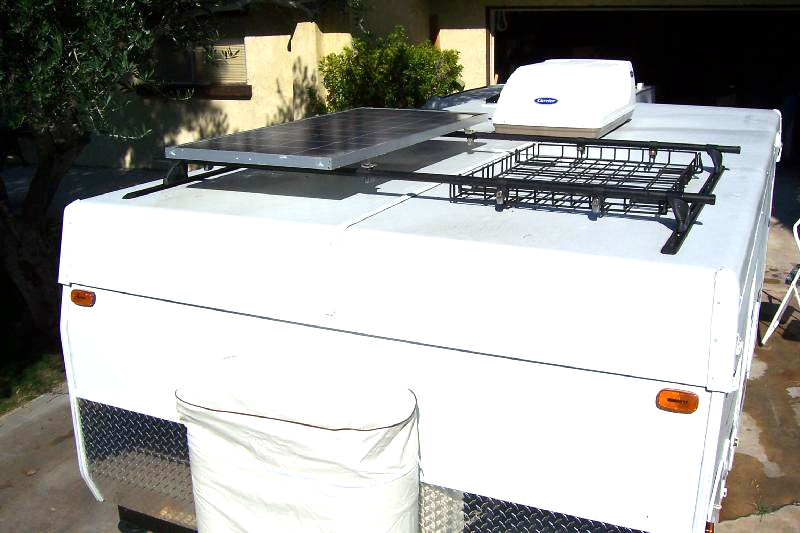

CONNECTING YOUR TENT TRAILER TO A WHEELED TOTE
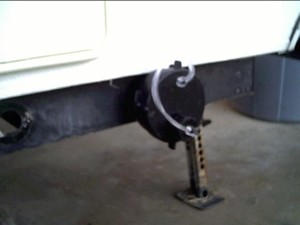
Most tent trailers do not have a standard RV waste disposal fitting, and if equipped with a drain it is a small diameter hose that does not fit a standard wheeled tote. So you become challenged to devise a plumbing system to connect your drain to the tote. And many campgrounds require portable totes to be sealed to the camper.
When we remodeled our 1992 Starcraft and added a shower and kitchen sink, we plumbed it with a standard RV sewer connection.
This allowed us to connect directly to a tote using a standard 3” sewer hose. But we found the wheeled totes to be cumbersome, heavy, and difficult to transport to a dump station, if one was available. A 10 gallon tote was too heavy to lift into the back of our SUV and required many trips over a 7 day camping trip. Large totes don’t require disposal as often but really can only be used where a dump station is close by, which limits your camping options.
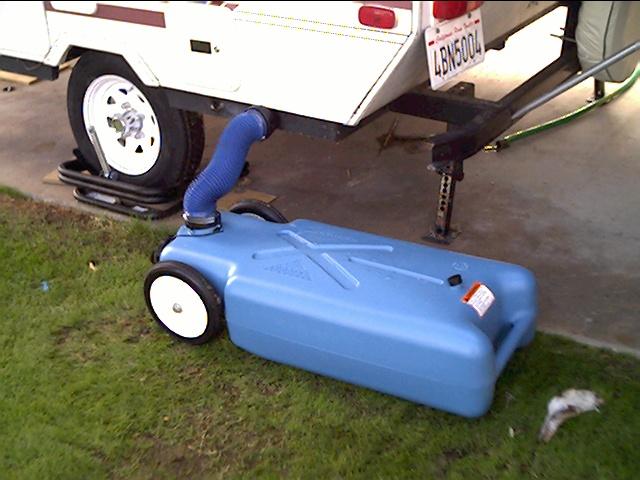
Tent trailers with a standard RV sewer connection
Today many of the larger model tent trailers come with a standard 3” sewer connection. Unfortunately, most of these connections are too low to the ground to hook up to a wheeled tote. We would have to find a spot that was not level and park the street side of the camper on the low side of the camp site. This way, we could raise that side of the camper to level it, and the sewer connection would be high enough to connect a wheeled tote.
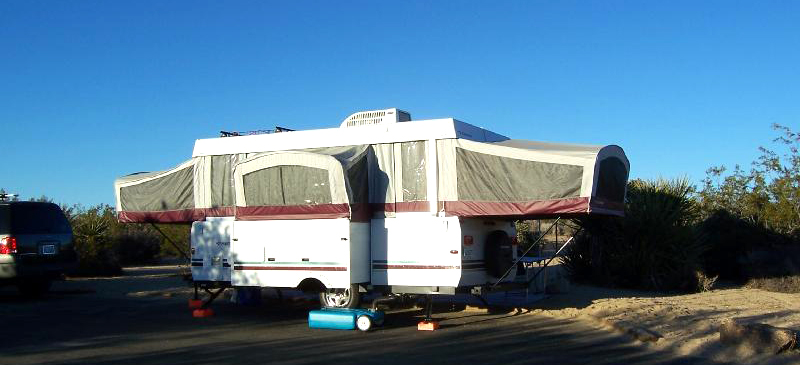
The solution for the low sewer connection is Smart Tote by Thetford. The sewer hose does not drain into the top like most totes, but into the bottom. This solved our connection problem, but did not solve the inherent problem of a big, cumbersome, and heavy tote.
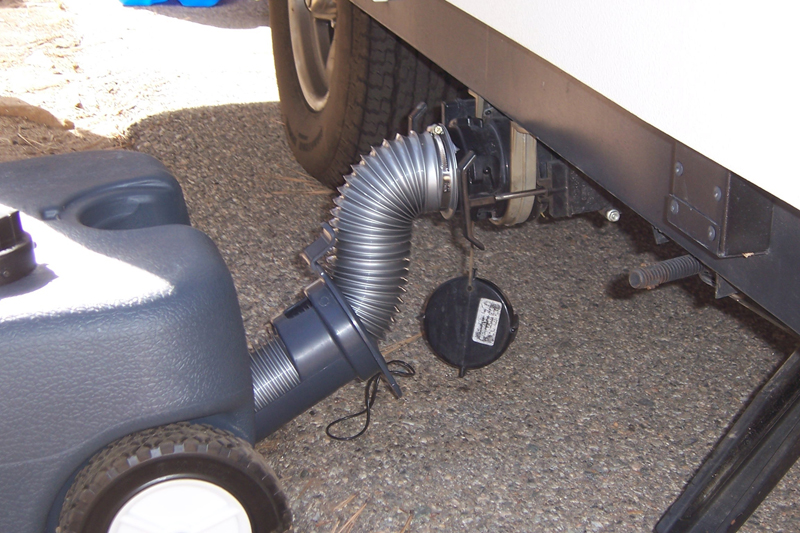
SEQUENTIAL AQUA-TAINERS
Years ago, my friend, Bill (Oz and Us), over at PopUpExplorer.com came up with a clever solution using two of the common 7 gallon Aqua-Tainers. If he was not the first one to use Aqua-Tainers, he was the first one to come up with a great solution of hooking them together.
Using adapters found at any hardware store, he connected an Aqua-Tainer to the camper. He did this with the typical small sewer hose found on older tent trailers, and he has done it with trailers with a standard 3” fitting. Then he connects the vents on each Aqua-Tainer with a hose. When the first one is full, the overflow is pushed into the 2nd one. With a little simple engineering one could probably add more Aqua-Tainers to the system.
The real benefit of this system is that each Aqua-Tainer is going to weigh about 50 lbs when full. Easy to put into the back of an SUV or truck and haul them to a dump station, or even a restroom where you can easily dump the contents into a toilet. You could even take them home full.
I could not use this system on our Starcraft, even after we lifted the suspension, because the connection was not high enough.
But once we raised the suspension on our 2006 Fleetwood Niagara, the Aqua-Tainer system worked perfectly. We haven’t used a wheeled tote since we raised the suspension in 2008. This was one of the main reasons we raised the suspension on this camper.
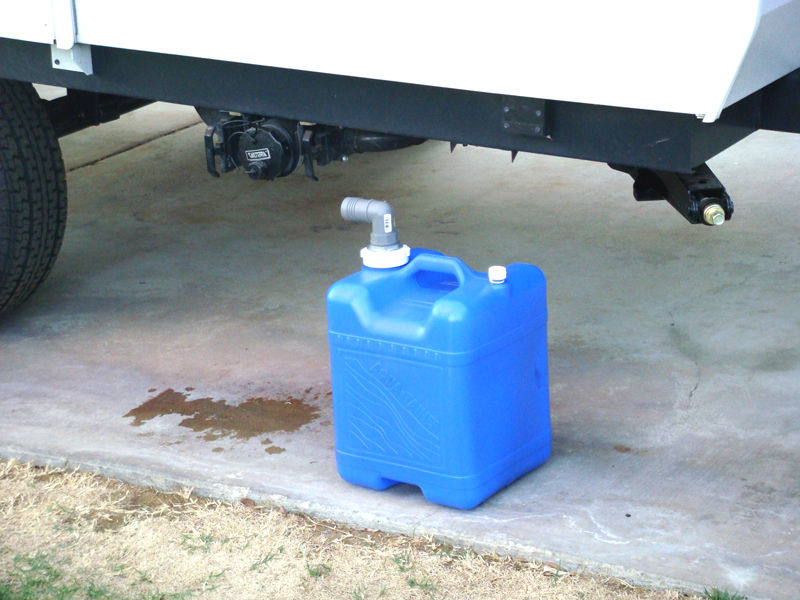

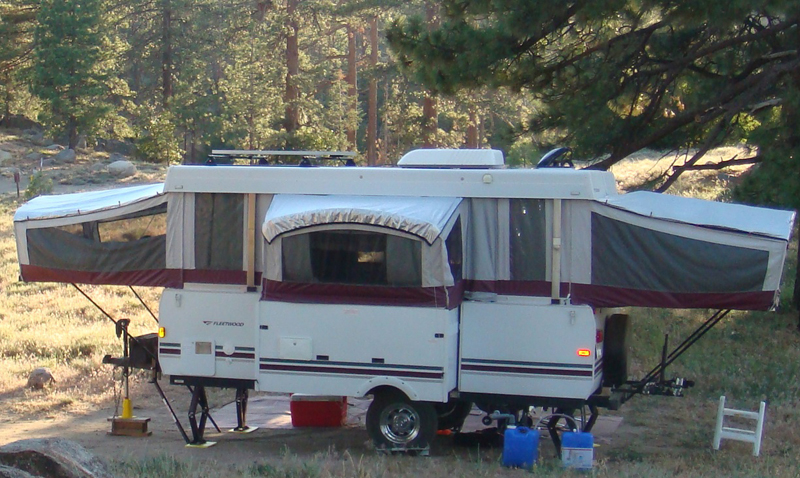
This website may be compensated for linking to other sites for sales of products. As an Amazon Associate I earn a small fee from qualifying purchases at no additional cost to the purchaser.


